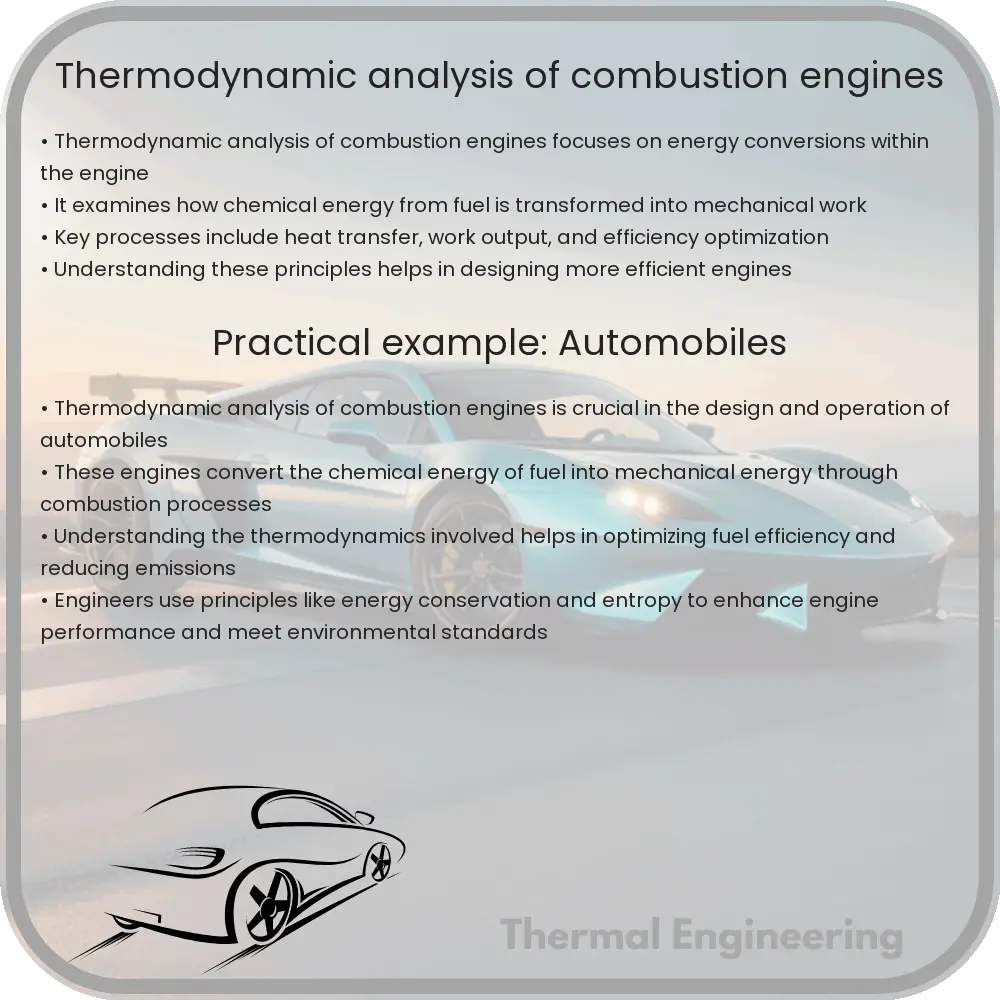Explore the role of thermodynamic principles in optimizing combustion engine efficiency and performance.

Thermodynamic Analysis of Combustion Engines
In the world of mechanical engineering, understanding the operation of combustion engines is crucial. These engines power everything from automobiles to large industrial machinery. Thermodynamic analysis, which focuses on the principles of heat and energy transformations, plays a fundamental role in optimizing engine performance and efficiency. Let us delve deeper into this fascinating topic.
Basic Principles of Thermodynamics in Combustion Engines
Combustion engines convert chemical energy from fuel into mechanical energy through a process of combustion—typically burning gasoline, diesel, or another fuel type. The operation can be studied through the laws of thermodynamics.
- The First Law of Thermodynamics states that energy cannot be created or destroyed, only converted from one form to another. In the context of a combustion engine, the chemical energy of the fuel is converted into heat energy by combustion and subsequently transformed into mechanical work.
- The Second Law of Thermodynamics emphasizes that every energy transfer or transformation increases the entropy of the universe. For combustion engines, this law explains why not all heat generated from fuel combustion can be converted into work; some energy is always lost as waste heat.
The Four Strokes of a Combustion Engine
The typical four-stroke combustion engine operates through the following phases:
- Intake Stroke: The intake valve opens, allowing the air-fuel mixture to fill the combustion chamber as the piston moves downward.
- Compression Stroke: The intake valve closes, and the piston compresses the air-fuel mix, heating it by virtue of compression.
- Power Stroke (Combustion Stroke): As the piston reaches its highest point, the spark plug ignites the compressed air-fuel mixture, causing combustion. The expanding gases from this combustion push the piston downward, generating work.
- Exhaust Stroke: The exhaust valve opens, and the piston moves upwards again, expelling the spent combustion gases from the cylinder.
Thermal Efficiency and Performance Parameters
One of the primary metrics used to gauge the efficiency of a combustion engine is thermal efficiency, which is defined as the ratio of work output to heat input. The formula for thermal efficiency (η) can be represented as:
η = (W / Qin) * 100%
Where W is the work done by the engine, and Qin is the heat added to the engine. Despite advances in technology, most combustion engines have a thermal efficiency of about 20-30%, largely due to the losses in heat and friction.
Thermodynamic Cycles in Combustion Engines
Two common theoretical models for analyzing engine cycles are the Otto cycle and Diesel cycle:
- Otto Cycle: Used primarily in gasoline engines, this cycle assumes constant volume heat addition.
- Diesel Cycle: Used in diesel engines, it assumes constant pressure heat addition.
Both cycles help engineers and scientists predict the efficiency and work output of an engine using idealized assumptions about the processes involved.
Conclusion
The thermodynamic analysis of combustion engines offers invaluable insights into their operation and efficiency. By understanding the heat and work interactions within these engines, engineers can continue to make advancements in reducing energy losses and improving the overall environmental impact of engine technology. As our understanding and technologies evolve, further enhancements in thermodynamic efficiency are likely, leading to more sustainable and powerful engines for the future.